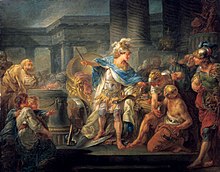Gordian knot

The term Gordian knot originally referred to artfully knotted ropes which , according to a Greek legend , were attached to the chariot of the Phrygian king Gordios . They inseparably connected the drawbar of the wagon with the yoke . The knot, which consists of the bast of the cornel cherry , became known because Alexander the Great is said to have cut it with his sword.
Today, the expression "to cut the Gordian knot" or "to untie the Gordian knot" means overcoming a difficult problem with energetic or unconventional means.
legend
According to legend, an oracle prophesied that whoever could untie the Gordian knot would gain control over Asia. Many bright and strong men tried this task, but none succeeded. Plutarch and Quintus Curtius Rufus describe that in the spring of 333 BC Alexander the Great on his march towards Persia simply cut this knot with his sword and thus heralded his triumphal march through Asia.
There is another variant of the tradition of Arrian , which refers to Aristobulus of Kassandreia accompanying Alexander, according to which Alexander is said to have loosened the knot through cunning. It is said that he realized that all he had to do was pull out the drawbar nail to pull the yoke away.
See also
literature
- Heinrich Wilhelm Stoll : Gordias . In: Wilhelm Heinrich Roscher (Hrsg.): Detailed lexicon of Greek and Roman mythology . Volume 1,2, Leipzig 1890, column 1694 ( digitized ).
Web links
- The Gordian knot , the legend in the knot dictionary "Gordian knot".
- Modern Gordian knot.
Individual evidence
- ↑ Duden online indicates the upper and lower case of Gordian : “the [famous] Gordian knot; “But” an [any] Gordian (indissoluble) knot ”. However, the phrase cannot always be strictly separated from the historical knot, because a transferred image mimics the original model. That is why the phrase - which equates any person with Alexander - is occasionally capitalized.
- ^ Dtv-Brockhaus-Lexikon. Volume 7, Brockhaus and dtv, Wiesbaden / Munich 1982, ISBN 3-423-03307-X , p. 98.